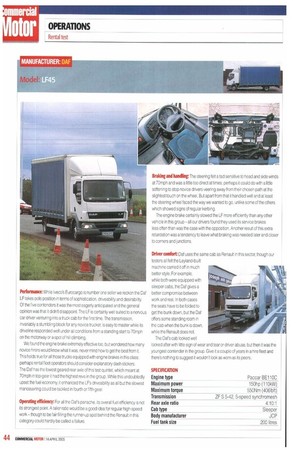PeriOnnance: While lveco's Eurocargo is number one seller we reckon
Page 46

If you've noticed an error in this article please click here to report it so we can fix it.
the Daf LF takes pole position in terms of sophistication, driveability and desirability. Of the five contenders it was the most eagerly anticipated and the general opinion was that it didn't disappoint. The LF is certainly well suited to a nervous car driver venturing into a truck cab for the first time. The transmission, invariably a stumbling block for any novice trucker, is easy to master Mile its driveline responded well under all conditions from a standing start to 70mph on the motorway or a spot of hill climbing.
We found the engine brake extremely effective too, but wondered how many novice hirers would know what it was, never mind how to get the best from it. This holds true for all those trucks equipped with engine brakes in this class; perhaps rental fleet operators should consider explanatory dash stickers. The Daf has the lowest geared rear axle of this test quintet, which meant at 70mph in top gear it had the highest revs in the group. While this undoubtedly upset the fuel economy, it enhanced the LF's driveability as all but the slowest manoeuvring could be tackled in fourth or fifth gear.
Operating effideniry: For all the Des panache, its overall fuel efficiency is not its strongest point. A taller ratio would be a good idea for regular high-speed work -though to be fair filling the runner-up spot behind the Renault in this category could hardly be called a failure. Braking and Wang: The steering felt a tad sensitive to head and side winds at 70mph and was a little too direct at times; perhaps it could do with a little softening to stop novice drivers veering away from their chosen path at the slightest touch on the wheel. But apart from that it handled well and at least the steering wheel faced the way we wanted to go, unlike some of the others which showed signs of regular kerbing.
The engine brake certainly slowed the LF more efficiently than any other vehicle in this group all our drivers found they used its service brakes less often than was the case with the opposition. Another result of this extra retardation was a tendency to leave what braking was needed later and closer to corners and junctions.
Driver =het Daf uses the same cab as Renault in this sector, though our testers all felt the Leyland-built machine carried it off in much better style. For example, while both were equipped with sleeper cabs, the Daf gives a better compromise between work and rest. In both cases the seats have to be folded to get the bunk down, but the Daf offers some standing room in the cab when the bunk is down, while the Renault does not.
The Daf's cab looked well looked after with little sign of wear and tear or driver abuse, but then it was the youngest contender in the group. Give it a couple of years in a hire fleet and there's nothing to suggest it wouldn't look as worn as its peers.
SPECIFICATION Engine type Paccar BE110C Maximum power 150hp (110kW) Maximum torque 550Nm (406Ibft)
Transmission ZF S 5-42, 5-speed synchromesh Rear axle ratio 4.10:1
Cab type Sleeper Body manufacturer JCP Fuel tank size 200 litres










































































































































































































